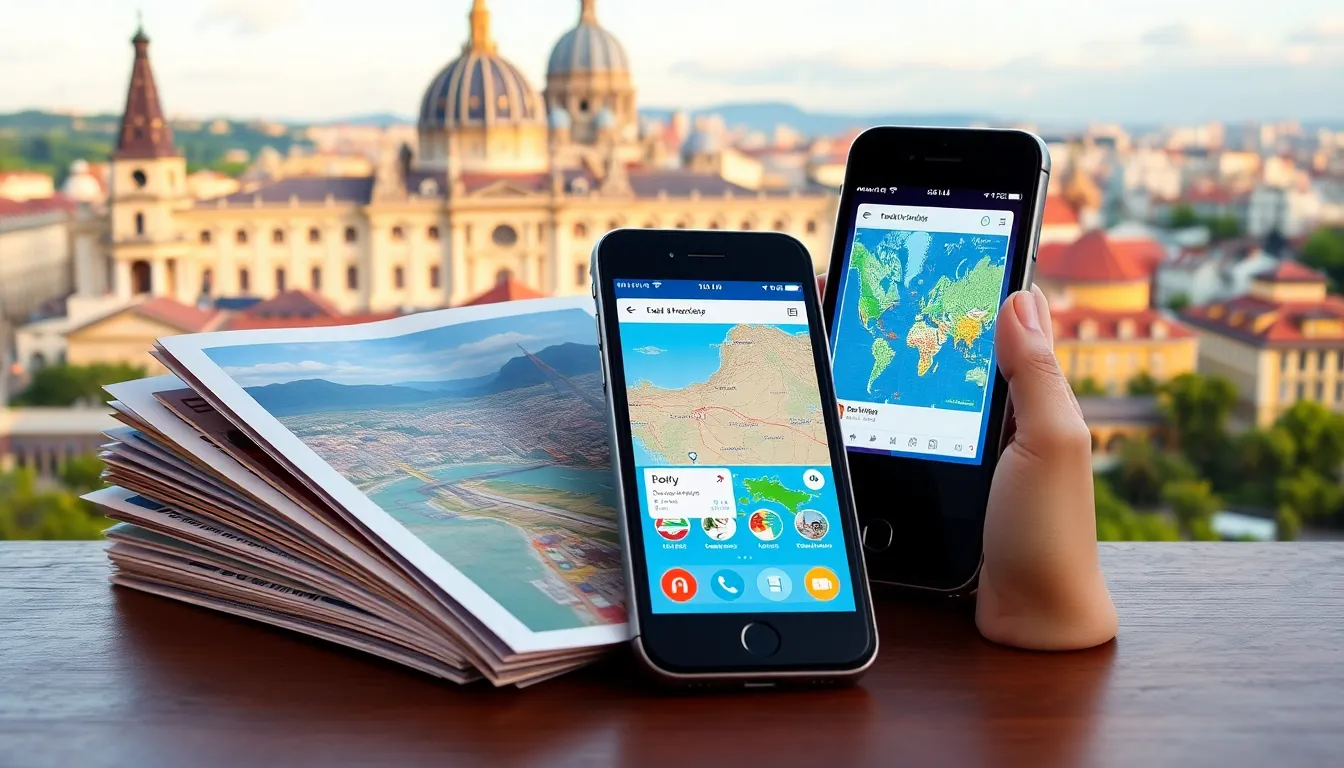In a world bursting with breathtaking landscapes and hidden gems, travel guides are the trusty sidekicks every adventurer needs. They’re like that friend who knows all the best spots—without the awkward small talk. Whether you’re a seasoned globetrotter or a weekend wanderer, having a solid travel guide can turn a good trip into a great one.
Table of Contents
ToggleOverview of Travel Guides
Travel guides serve as essential resources for travelers seeking to explore new locations. They provide detailed information about accommodations, attractions, and local cuisine. It’s common for travelers to refer to guides for insights into cultural norms and transportation options.
Many guides offer practical tips, such as ideal travel seasons and safety advisories. Certain travel guides focus on niche interests like outdoor adventures or culinary experiences. These specialized guides cater to diverse preferences, enhancing the travel experience for everyone.
Moreover, digital travel guides often include up-to-date information and user reviews. This functionality allows travelers to make informed choices based on recent experiences. Printed guides, while less dynamic, offer thorough insights into destinations, complete with maps and historical context.
Travelers can benefit from both types, depending on their planning needs. Utilizing a mix of resources can lead to a richer understanding of a destination. Local guides may also provide personalized experiences, offering hidden gems away from tourist spots.
Leveraging travel guides can streamline the planning process, ensuring that every traveler finds their best-fit options. In doing so, they not only save time but also discover unique opportunities that enhance their journeys. Each trip becomes more memorable with the right guidance, making travel guides invaluable companions.
Types of Travel Guides

Travel guides come in various formats, each serving unique needs for different types of travelers. Understanding these types enhances the journey.
Printed Travel Guides
Printed travel guides provide in-depth insights and comprehensive details that digital formats can sometimes lack. Many travelers appreciate these guides for their tactile nature and ease of use, particularly in areas with limited connectivity. Printed guides often include maps, historical context, and curated recommendations from experts. They appeal to those who prefer turning pages and accessing information without battery concerns. High-quality printed guides often cover essential topics like local customs, safety tips, and dining options. Travelers can find value in the design and layout, which is intended to facilitate navigation during trips.
Digital Travel Guides
Digital travel guides offer real-time updates and interactive features, appealing to tech-savvy travelers. These guides typically provide user-generated reviews, ensuring up-to-date insights into attractions and accommodations. Many apps categorize information by interests, helping users find specific activities tailored to their preferences. Connectivity enhances the experience, allowing travelers to explore new destinations on-the-go. A digital guide can complement printed versions, providing instant access to information and maps right from a smartphone or tablet. With many growing options, travelers can customize their experience and even share their adventures seamlessly.
Features of Effective Travel Guides
Effective travel guides provide essential information, enhancing the overall travel experience. They should encompass detailed itineraries, local insights, and practical tips for various travelers.
Detailed Itineraries
Detailed itineraries outline day-by-day plans for travelers, ensuring they make the most of their time. Itineraries typically suggest major attractions, dining options, and transportation methods. Each day should prioritize key experiences while allowing for exploration. Travelers appreciate clear timelines, helping them navigate their journeys efficiently. Recommending alternate routes or optional activities can accommodate diverse interests. Including estimated costs for activities enhances budget planning. A well-structured itinerary takes the stress out of decision-making, allowing travelers to focus on enjoying their adventures.
Local Insights and Tips
Local insights and tips enrich travelers’ experiences, providing them with cultural knowledge and practical advice. Guides should include connoisseur recommendations for dining and attractions unique to the area. Highlighting customs, etiquette, and language phrases adds depth to the experience. Unwritten rules, such as dining practices or greeting etiquette, help travelers blend in with locals. Safety tips, including neighborhood highlights or areas to avoid, enhance personal security. Offering information about local events or seasonal attractions can lead to memorable encounters. Local insights turn an ordinary trip into an unforgettable journey.
Choosing the Right Travel Guide
Selecting the ideal travel guide significantly impacts the quality and enjoyment of a trip. Consider the specific needs and interests of the traveler. Some individuals may prefer detailed itineraries focusing on sightseeing, while others prioritize cultural experiences or adventure activities.
Evaluate the format of the travel guide, whether printed or digital. Printed guides often provide comprehensive information and are excellent for areas with limited connectivity. Digital guides, on the other hand, offer real-time updates, interactive maps, and user-generated reviews, which can enhance decision-making during trips.
Examine the depth of information provided within the guide. Effective travel guides include essential details such as accommodations, dining options, and local attractions. An ideal guide presents not only practical tips, like transportation methods, but also insights into cultural norms and customs.
Look for recommendations tailored to personal interests. Some guides specialize in unique niches, such as culinary experiences, outdoor adventures, or historical exploration. Choosing a guide that matches specific travel goals ensures a more fulfilling experience.
Consider user reviews and ratings if selecting a digital guide. These ratings provide firsthand accounts of the guide’s effectiveness and reliability. Scanning reviews helps identify potential pitfalls or standout features.
Assess the guide’s layout and usability. A well-organized travel guide with easy navigation simplifies the planning process. Clear section headings, maps, and bullet points enhance the user experience, allowing quick access to necessary information.
By prioritizing these factors, travelers can choose a travel guide that best fits their needs, elevating their journey to new heights of enjoyment.
Popular Travel Guide Brands
Several travel guide brands stand out for their comprehensive resources and dependable insights.
Lonely Planet offers extensive coverage of global destinations, appealing to budget-conscious travelers. Their guides feature detailed itineraries, local recommendations, and essential travel tips.
Rick Steves focuses on European travel, providing cultural insights and practical advice tailored for immersive experiences. His guides often emphasize local experiences and transportation options.
Fodor’s specializes in a blend of luxury and practical travel, catering to diverse preferences. Their guides feature curated dining suggestions, accommodations, and activities for affluent travelers.
Frommer’s combines expert advice with user-friendly layouts, addressing varied interests. Their guides often highlight hidden gems and well-known attractions, making them suitable for all kinds of travelers.
National Geographic emphasizes adventure and exploration, focusing on cultural and natural wonders. Their guides offer valuable insights into sustainability and local customs.
DK Eyewitness utilizes vibrant images and maps, effectively enhancing user experience. Their visual approach helps travelers navigate destinations and discover attractions efficiently.
TripAdvisor primarily serves as a digital platform, leveraging user-generated content and reviews. Travelers benefit from real-time insights into accommodations, dining, and local attractions.
Google Travel transforms travel planning through its technology, offering personalized recommendations based on user preferences. Their features streamline the research process, integrating different resources into one platform.
These brands provide a range of options for travelers wanting reliable information, catering to various interests and travel styles.
Conclusion
Travel guides are indispensable tools that enrich the journey of every traveler. They provide valuable insights and practical tips that can transform a simple trip into an unforgettable adventure. By choosing the right guide—whether printed or digital—travelers can access tailored recommendations and essential information that cater to their unique preferences.
With a wealth of options available from reputable brands, travelers can find the perfect resource to enhance their experience. Whether exploring bustling cities or serene landscapes, effective travel guides ensure that every moment is filled with discovery and enjoyment. Embracing these resources can lead to deeper connections with destinations and create lasting memories.






